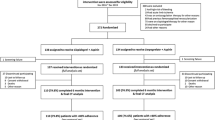Abstract
Percutaneous transluminal angioplasty of aortoiliac and femoropopliteal atherosclerotic lesions can provide long-lasting hemodynamic improvement. High-dose aspirin is commonly prescribed as reocclusion prophylaxis, but low doses would be preferable because of fewer adverse effects. We performed a double-blind, randomized, controlled clinical trial in patients with peripheral vascular disease with lesions appropriate for angioplasty. We compared the efficacy and side effects of two doses of aspirin (50 mg vs. 900 mg daily) during a period of 12 months after angioplasty. A total of 359 patients were evaluated: 175 were randomly assigned to treatment with 900 mg aspirin daily and 184 to 50 mg aspirin a day. Thirty-nine patients developed restenosis at the angioplasty site; the cumulative percentage of event-free survival after 1 year (patency rate) was 85% in the 900-mg group and 84% in the 50-mg group. An equivalence test showed the two groups equivalent with respect to restenosis rates (P = 0.003 for an equivalence region of < 10% difference). Nine patients (5%) in the 900-mg group had serious gastrointestinal side effects (peptic ulcer, eight; erosive gastritis requiring transfusion, one) compared to two (peptic ulcer) in the 50-mg group (P = 0.03). The results of our study show that a dose of 50 mg aspirin a day is as effective as one of 900 mg for the prevention of restenoses after lower limb angioplasty, and that severe gastrointestinal side effects are less frequent.
Similar content being viewed by others
Abbreviations
- PTA:
-
percutaneous transluminal angioplasty
References
Bollinger A, Breddin K, Hess H, Heystraten FMJ, Kollath J, Konttila A, Pouliadis G, Marshall M, Mey T, Mietaschk A, Roth FJ, Schoop W (1981) Semiquantitative assessment of lower limb atherosclerosis from routine angiographic images. Atherosclerosis 38:339–346
Ciampi A, Hogg SH, McKinney S, Thiffault J (1988) RECPAM: a computer program for recursive partition and amalgamation for censored survival data and other situations frequently occurring in biostatistics. 1. Methods and program features. Comput Methods Programs Biomed 26:239–256
Coffman JD (1992) Intermittent claudication - be conservative. N Engl J Med 325:577–578
The Dutch TIA Trial Study Group (1991) A comparison of two doses of aspirin (30 mg vs. 283 mg a day) in patients after a transient ischemic attack or minor ischemic stroke. N Engl J Med 325:1261–1266
FitzGerald GA, Oates JA, Hawiger J, Maas RL, Roberts II LJ, Lawson JA, Brash AR (1983) Endogenous biosynthesis of prostacyclin and thromboxane and platelet function during chronic administration of aspirin in man. J Clin Invest 71:676–688
Gallino A, Mahler F, Probst P, Nachbur B (1984) Percutaneous transluminal angioplasty of the arteries of the lower limbs: a 5 year follow-up. Circulation 70:619–623
Gruntzig A, Kumpe DA (1979) Technique of percutaneous transluminal angioplasty with the Gruntzig balloon catheter. AJR Am J Roentgenol 132:547–552
Hauck WW, Anderson S (1986) A comparison of large sample confidence interval methods for the difference of two binomial probabilities. Am Stat 40:318–322
Hess H, Mietaschk A, Deichsel G (1985) Drug-induced inhibition of platelet function delays progression of peripheral occlusive arterial disease. Lancet 1:415–419
Hewes RC, White RI Jr, Murray RR, Kaufman SL, Chang R, Kadir S, Kinnison ML, Mitchell SE, Auster M (1986) Long-term results of superficial femoral artery angioplasty. AJR Am J Roentgenol 146:1025–1029
Huskisson EC (1974) Measurement of pain. Lancet 11:1127–1131
Johnston KW (1992) Femoral and popliteal arteries: reanalysis of results of balloon angioplasty. Radiology 183:767–771
Johnston KW, Rae M, Hogg-Johnston SA, Colapinto RF, Walker PM, Baird RJ, Sniderman KW, Kalman P (1987) 5-year results of a prospective study of percutaneous transluminal angioplasty. Ann Surg 206:403–413
Kaplan EL, Meier P (1958) Nonparametric estimation from incomplete observations. J Am Stat Assoc 53:457–481
Krepel VM, van Andel GJ, van Erp WFM, Breslau PJ (1985) Percutaneous transluminal angioplasty of the femoropopliteal artery: initial and long-term results. Radiology 156:325–328
Murray RR, Hewes RC, White RI, Mitchell SE, Auster M, Chang R, Kadir S, Kinnison ML, Kaufman SL (1987) Longsegment femoropopliteal stenoses: is angioplasty a boon or a bust? Radiology 162:473–476
Patrono C, Ciabattoni G, Patrignani P, Pugliese F, Filabozzi P, Catella F, Davi G, Forni L (1985) Clinical pharmacology of platelet cyclooxygenase inhibition. Circulation 72:1177–1184
Probst P, Cerny P, Owens A, Mahler F (1983) Patency after femoral angioplasty: correlation of angiographic appearance with clinical findings. AIR Am J Roentgenol 140:1227–1232
Rosenkranz B, Frölich JC (1985) Plasma concentrations and anti-platelet effects after low dose acetylsalicylic acid. Prostaglandins Leukot Med 19:289–300
SALT Collaborative Group (1991) Swedish Aspirin Low-Dose Trial (SALT) of 75 mg aspirin as secondary prophylaxis after cerebrovascular ischaemic events. Lancet 338:1345–1349
Steering Committee of the Physicians' Health Study Research Group (1989) Final report on the aspirin component of the ongoing physicians' health study. N Engl J Med 321:129–135
Stokes KR, Strunk HM, Campbell DR, Gibbons GW, Wheeler HG, Clouse ME (1990) Five-year results of iliac and femoropopliteal angioplasty in diabetic patients. Radiology 174:977–982
Tegtmeyer CJ, Hartwell GD, Selby JB, Robertson R Jr, Kron IL, Tribble CG (1991) Results and complications of angioplasty in aortoiliac disease. Circulation 83 [Suppl 1]: 1·53–1·-60
UK-TIA study group (1991) The United Kingdom transient ischaemic attack (UK-TIA) aspirin trial: final results. J Neurol Neurosurg Psychiatry 54:1044–1054
van Andel GJ, van Erp WFM, Krepel VM, Breslau PJ (1985) Percutaneous transluminal dilatation of the iliac artery: long-term results. Radiology 156:321–323
Author information
Authors and Affiliations
Additional information
This work was supported by grants from the Bundesministerium für Forschung and Technologie, Germany
Correspondence to: C. Ranke
Rights and permissions
About this article
Cite this article
Rankel, C., Creutzig, A., Luska, G. et al. Controlled trial of high-versus low-dose aspirin treatment after percutaneous transluminal angioplasty in patients with peripheral vascular disease. Clin Investig 72, 673–680 (1994). https://doi.org/10.1007/BF00212985
Received:
Revised:
Accepted:
Issue Date:
DOI: https://doi.org/10.1007/BF00212985




